The decorative houseplant Deffenbachia comes from the tropics and is commonly known as the dumb cane plant. Because of their huge, spectacular leaves and tolerance for low light, many Dieffenbachia species are popular indoor plants. The variegated creamy-white and green leaves of varieties of dumb cane plants such as Dieffenbachia seguine, Dieffenbachia amoena, and Dieffenbachia Camille are attractive. Dieffenbachia plants are incredibly easy to take care of at home, which is why they are so popular.
How to care for types of Dieffenbachia: Dumb cane plants grow in a moist potting mixture and have an average humidity of low to medium light. When the top inch of soil is dry, water Dieffenbachia plants thoroughly. Fertilize monthly from spring to summer, keeping the temperature between 65°F and 75°F (18°C and 23°C).
Dieffenbachia, a genus found in Central and South America’s tropics, is home to dumb cane plants. In bright light, as long as they are shielded from direct sunlight, these plants grow fast. Large leaves, up to 10″ (25 cm) broad and 20″ (47 cm) long, develop from a central stalk or cane.
Indoor flowering of these tropical houseplants is uncommon. All types of indoor Dieffenbachia plants may be grown according to this guide. You’ll also learn how to manage challenges that may harm the development of these lovely foliage plants.
Varieties of Dieffenbachia Plants

Deffenbachia varieties come in a variety of shapes and colors, with beautiful leaf patterns. The intriguing pattern on the big, broad leaves of Dieffenbachia seguine distinguishes it from other types of dumb cane plants. In this section, we’ll take a quick look at some of Dieffenbachia’s most popular varieties, sometimes referred to as the leopard lily.
Large yellowish or creamy leaves with green borders are found on several Dieffenbachia plants. Dieffenbachia maculata ‘Camille,’ Dieffenbachia ‘Tropical Marianne,’ Dieffenbachia ‘Honeydew,’ and Dieffenbachia ‘Tropic Honey’ are some examples of these variegated plants. Dieffenbachia seguine, Dieffenbachia amoena, Dieffenbachia picta, and other Dieffenbachia maculata cultivars are examples of these plants.
How to Care for Dumb Cane (Dieffenbachia) Plants at Home
Despite the fact that Dieffenbachia is a maintenance-free plant species, there are a few things you should know. Your ornamental plants will thrive if you take care of them properly.
Dieffenbachia (Dumb Cane) Light Requirements

To thrive, Deffenbachia maculata ‘Camille’ needs medium to bright, indirect sunlight. Bright light keeps the variegated leaves vibrant, even though Dieffenbachia can grow in low-light conditions. In addition, to keep healthy development going, there must be plenty of light. When leaves get brown due to too much direct sunlight, it’s a common symptom.
A bright, east-facing windowsill is the best location for Dieffenbachia plants. The bright spot and early morning light are ideal for healthy growth. Keep your dumb cane plants away from the window or have them behind a sheer curtain if you grow them in a west- or south-facing room.
The Dieffenbachia plants with deeper leaves are generally the ones that thrives in poor lighting. As a result, low-light rooms and workplaces can be easily accommodated by species such as Dieffenbachia ‘Snow,’ Dieffenbachia seguine, and Dieffenbachia maculata. Some types of dumb cane plants prefer low light conditions more than others.
It might be a indication that the plant requires extra sunlight if you notice that the canes or stems become leggy. Another indication of insufficient light is leaf drop. Most dumb can plants may continue to thrive when growing in the dark, although development will be reduced to a minimum.
The Best Potting Soil for Dieffenbachia Plants

Several cultivars of Dieffenbachia amoena feature decorative variegated leaves, which prefer moist soil with excellent drainage. A combination of regular potting soil and perlite is the finest sort of potting mix for dumb canes. To allow excess water to drain well, the addition of perlite helps improve soil consistency.
The kind of soil you use for planting isn’t important to Deffenbachia. The potting substrate must not get waterlogged or soggy, which is the most important factor. Overwatering plants must be avoided at all costs. Thus, to avoid soil moisture problems, you should use pumice, perlite, or coarse sand.
Putting a layer of pebbles in the bottom of the pot is one excellent tip for obtaining the finest soil consistency for dumb cane plants. The little stones enhance the drainage of water through the pot’s holes. To help Dieffenbachia plants get the nutrients and oxygen they need for healthy growth, the extra area at the bottom of the container improves airflow.
Dumb Cane Plant Watering Guide
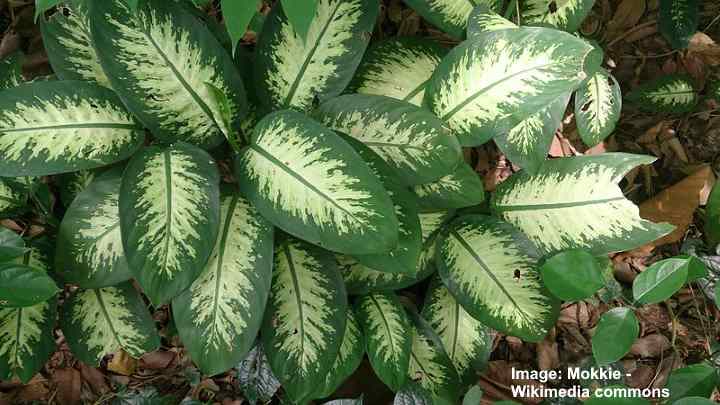
Only when the top layer of soil dries does Dieffenbachia seguine ‘Tropic Snow’ have huge glossy-pale green leaves with a deeper green border and midrib. Overwatering the plant is prevented by allowing the top 1″ to 2″ (2.5–5 cm) of soil to dry. The potting mix around the roots is kept moist, but not excessively damp, by this watering schedule. Dumb cane leaves that turn yellow are one sign of overwatering.
Watering Dieffenbachia is best done with room temperature water that is drenched into the soil. Add enough water to fill the drainage holes until it begins to flow out. Next, let all the superfluous water to flow out. When the top layer of soil is dry, you should water the plant again.
The roots are kept hydrated by adequate watering. It’s safest to assume that your dumb cane and leopard lily plants need watering. watering the potting soil less often is preferred over watering it frequently. Deffenbachia is a drought-tolerant plant species.
When it comes to Dieffenbachia, avoid one of the watering mistakes by giving it a little water on a regular basis. Watering plants in this manner encourages a moist environment at the surface of the earth, preventing water from reaching the roots. Even if you shower your plant, it may exhibit evidence of underwatering. When your Dieffenbachia is watering incorrectly, some symptoms may appear:
- Underwatering leads to shriveled leaves.
- Due to watering small and often, fungus gnats live in plant soil.
- When the potting mix is too wet, white mold appears on the surface of the soil.
- Because of root rot and soggy soil, the leaves are drooping and discolored.
Temperature for Growing Dumb Cane Plants
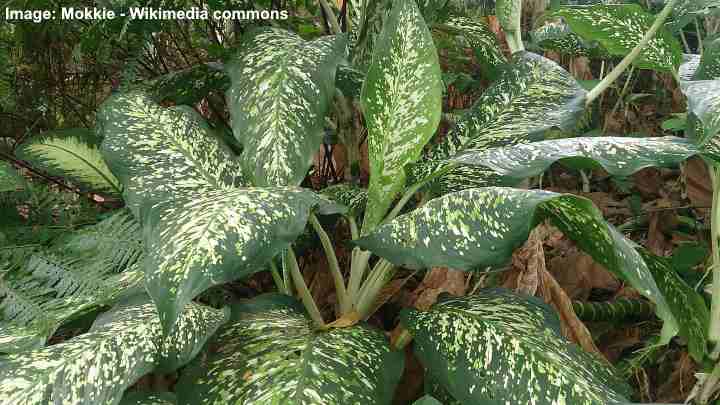
Dieffenbachia thrives in room temperatures of 70 degrees Fahrenheit, making them the ideal low-maintenance houseplant. For optimum development, keep the temperature between 65°F and 75°F (18°C and 23°C). At temperatures ranging from 40°F to 60°F (4°C to 15°C), dumb cane plants may grow, albeit at a slow pace.
It’s important to avoid sudden temperature changes when growing dumb cane plants indoors. Leaves may curl or stalks might droop in the summer if chilly air from open windows or an air-conditioning unit is blows. The Dieffenbachia may be near hot radiators, which causes heating issues in the winter.
In USDA zones 11 and 12,deffenbachia plants flourish outdoors. You may bring indoors dumb cane plants if you reside in colder areas and need to bloom during the summer. The plant will thrive and remain healthy as long as the temperature isn’t below 60°F (15°C) and it’s in a shaded or partially shaded environment.
Humidity Requirements to Grow Dieffenbachia Indoors

Dumb cane plants, like their native tropical locations, prefer high humidity. This non-fussy houseplant, on the other hand, thrives in normal room humidity. You should try to increase air moisture if you see that the leaf tips are starting to brown. Weekly misting of the plant leaves is the most effective method.
Keeping humidity consistent with temperature is important. Fungal infections may develop if there is too much air moisture in the colder temperatures. Brown or black spots on leaves may be a result of this. Since household heating creates dry air in the winter, you may need to mist more often.
Deffenbachia plants make wonderful shower plants. These plants prefer warm temperatures and humidity, but they can tolerate low light. As a result, they’ll thrive in bathrooms, kitchens, and other warm areas with little natural illumination.
Dumb Cane Speed of Growth
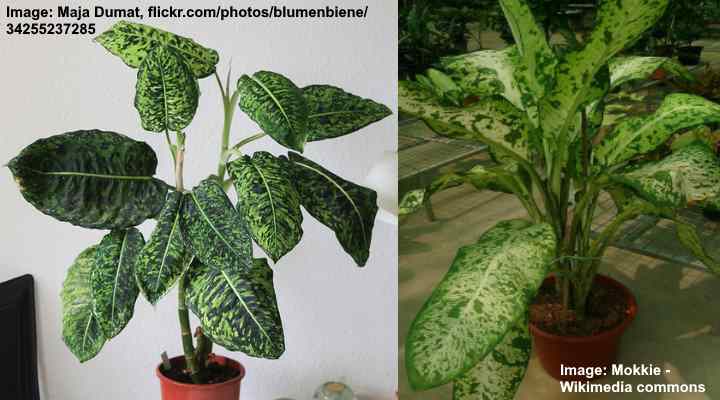
Dieffenbachia plants thrive in bright, indirect light and warm temperatures, as shown by Dieffenbachia ‘Reflector’ (left) and Dieffenbachia ‘Galaxy’ (right). The plant may grow to be nearly 3.5 feet (1 meter) tall and have huge bushy leaves under ideal circumstances.
In the winter and colder temperatures, dumb cane plant growth slows dramatically. This houseplant’s growth rate can also be slowed by a lack of bright light. If you’re looking for indoor plants that grow over 3 feet (1 meter) tall, read this article on tall houseplants.
Flowers on Dieffenbachia Plants

The delicate green modified leaf is known as a bract or spathe, and the cream-white spike (known as spadix) is the blossom in this picture. Flowers with a spathe (which is really modified leaf) and spadix develop from dumb cane plants when they bloom.
Other aroid plants in the Araceae family, such as species of anthurium, have similar types of Dieffenbachia flowers. It is best to clip the blooming branches since dumb cane blossoms are so minor. To encourage healthy, vibrant leaves, cutting the stems assists concentrate energy into vigorous plant development.
The Best Way to Fertilize Dieffenbachia
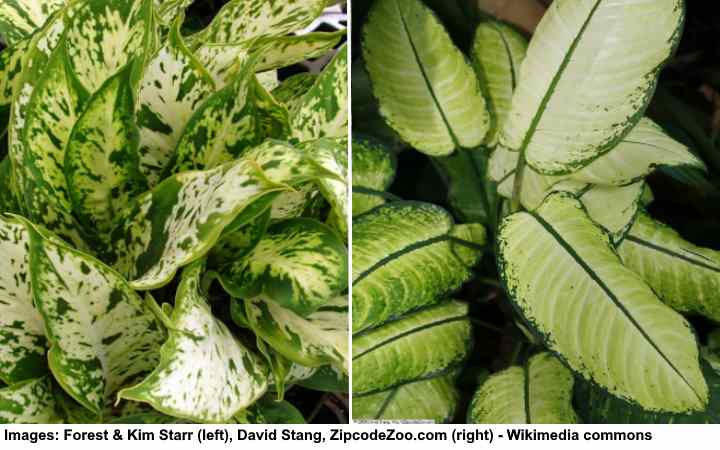
Feed a dumb cane plant with regular householdplant fertilizer every month to encourage fast growth. During the growing season, spring and summer, feed the plants only once a month and refrain from doing so throughout winter. If you take care of your Dieffenbachia properly, you may determine that you don’t need to apply fertilizer.
It’s important to flush the soil frequently if you decide to apply fertilizer. Mineral salts may build up to the point that leaves wilt and develop brown tips as a result of their growth. Pour water into the potting soil for two to three minutes every three months. This method of drenching the soil helps to eliminate excess fertilizer.
How to Prune Dumb Cane Plants for Best Growth
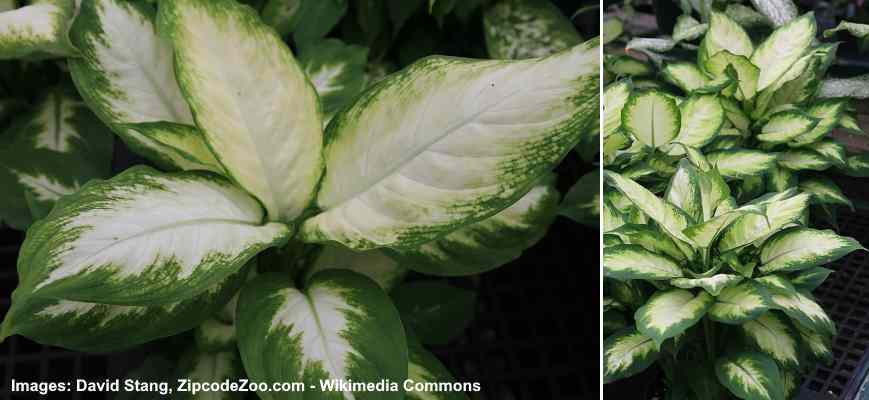
Bushy, healthy growth and a better appearance are promoted by pruning Dieffenbachia in the spring (as seen in the photo). Lanky stems are prevented from developing and rejuvenated by yearly trimming. Any brown or dead leaves or stems should be removed as well. Dumb cane plants can be controlled by pruning.
Cut the leaf stem just above the node to remove straggly stems or unsightly foliage. Leaves should develop at the node level, just below it. If you want bushy, healthy development, pinch off new growth on a weekly basis to achieve a more compact look.
Propagating Dumb Cane Plants
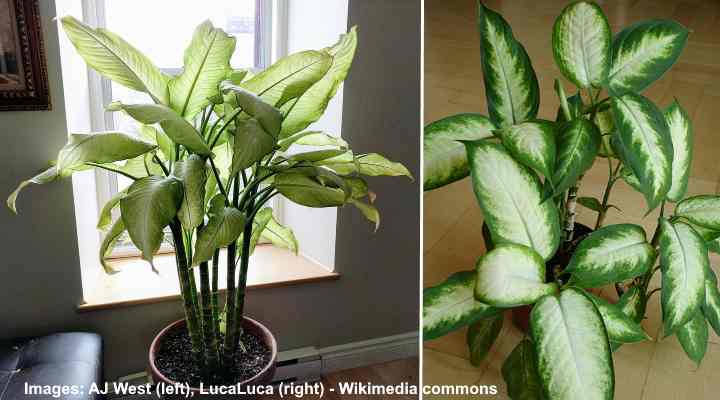
You may easily grow Dieffenbachia plants by cutting stem cuttings and putting them in water. You may establish new dumb can plants by using stems removed from pruning.
Make sure that the stems you choose for propagation have a node. Leave the cut ends to dry for one day. After that, gently place roots sideways on moist sand or perlite. After that, you may move the rooted Dieffenbachia cutting to a new pot. By putting stems in a jar of water, you may alsoroot them. Before transferring to potting soil, place the jar in a sunny, warm area and allow roots to develop.
How to Repot Dieffenbachia Plants

When a rootbound dumb cane plant is repotted, it will benefit. Since they are easy to look after, they don’t need to be repotted very often. When to repot the plants depends on whether you see signs of sluggish development or roots protruding from the pot’s drainage openings.
Choose a pot that is one or two sizes larger and has drainage holes to repot your Dieffenbachia plant. Remove the plant from its current pot with care. Remove any tangled roots and remove excess dirt from them. Look for brown, mushy roots and cut them off with clean, sterile equipment if necessary. Using the correct kind of potting soil, repot in a new container.
Repotting may occasionally stress the plant, so only repot when necessary. Dieffenbachia species have poisonous sap that may cause skin irritation. As a result, when handling cuttings, it’s recommended to wear protective gloves.
Pest and Diseases Affecting Dieffenbachia Growth

Spider mites or mealybugs are two pests that may harm Dieffenbachia. The excellent news is that dumb cane plants are seldom afflicted by pests. Bug infestation on these houseplants, on the other hand, is a serious problem that needs to be resolved right away. The best approach to get rid of these pests for good is usually insecticidal soap. Little cotton-like growths on the stems and beneath the leaves are indications of mealybugs on dumb cane plants. Spider mites are sometimes difficult to detect.
Webbing under the leaves and on the stems is a tell-tale sign of these houseplant pests. Overwatering is the most common cause of diseases that affect Dieffenbachia plants. watering dumb cane plants is to only water when the soil is partially dry, according to the golden rule.
Are Dieffenbachia Plants Toxic?
Calcium oxalates, which are poisonous to humans, may cause skin irritation and swelling in dumb cane plants. According to medical literature, none of Dieffenbachia plants should be consumed. Swelling, irritation, and ulcers in the mouth and esophagus may occur after you eat the plant.
Skin irritation or allergic responses can also occur while handling the plant. Cats, dogs, and other household pets are also poisonous to deffenbachia plants. Signs of poisoning include the following, according to the American Society for the Prevention of Cruelty to Animals (ASPCA):
- Oral irritation
- Burning in the oral cavity
- Excessive drooling
- Vomiting
- Difficulty swallowing
FAQs About Growing Dieffenbachia Indoors
What are White Spots on Dumb Cane Plant Leaves?
Mealybugs are most likely the white spots on Dieffenbachia that are fluffy or hairy. To get rid of them, use insecticidal soap on your hands. Calcium from hard water may also appear as little white specks on dumb cane leaves. Leaving tap water out for 24 hours before using to mist the leaves is the solution to this problem.
Why are the Leaves of Dieffenbachia Turning Yellow?
Overwatering, too much sunlight, a lack of humidity, or a nutrient deficiency are all common reasons for dumb cane leaves to turn yellow. You’ll have to use a process of elimination to sort through these problems. So, reduce the watering frequency, move to a brighter area, or fertilize every month to avoid this.
Why are Dumb Cane Plant Leaves Leaf Tips Brown?
The most likely cause of Dieffenbachia’s brown leaves is a lack of humidity. Misting the leaves more often is the answer. However, if you see that the entire leaf has become withered, it might be due to too much water. Before watering, check the soil for moisture.